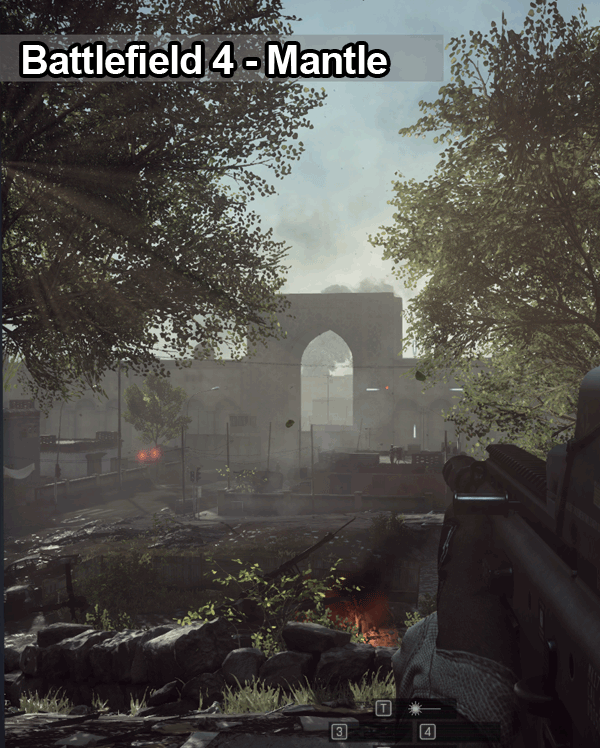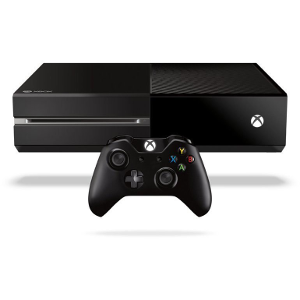AMD Mantle: A Graphics API Tested In Depth
AMD's Mantle is available to users of certain Radeon cards, as are the first few titles with corresponding API support. We gathered up a number of CPUs and graphics boards, fired up Battlefield 4 and Thief, and set off on a benchmarking odyssey.
Image Quality Comparison And Wrap-Up
Image Quality Comparison: Mantle vs. DirectX
When the Mantle patch first launched, we saw evidence of inconsistent visual output using the newer API compared to DirectX 11 in Battlefield 4. So, I took some screenshots in the two games we tested for a comparison. Here are the results:
Previously, it was reported that there was a difference in saturation and contrast between Mantle and DirectX in Battlefield 4. But at this point in development, the disparity is apparently gone. We know DICE addressed the bug publicly and claimed to have fixed it in a subsequent patch.
As for Thief, I didn't find any meaningful image quality disparities between Mantle and DirectX.
How does Mantle impact the future of gaming?
Today we thoroughly tested the only two benchmarkable titles with AMD Mantle support. Thief exhibits clear (and impressive) performance gains under the API and really does mitigate much of the platform-oriented bottleneck imposed by low-cost CPUs. Battlefield 4 demonstrates gains with a Radeon R9 290X, while mid-range and low-end discrete cards suffer from what AMD suggests is a memory-related issue under Mantle. I tested a Radeon R9 270X with 4 GB as verification, and while Mantle didn't hurt performance, it also didn't enjoy an advantage. AMD says Mantle is in its beta stage, and so perhaps anomalies like this are expected as we sort through corner cases.
Regardless, based on most of our tests (and developer testimony), it's pretty clear that Mantle offers certain advantages over DirectX 11, at least. We don't have any OpenGL-based games to compare, but the claim is that both entrenched graphics APIs are limited compared to Mantle. So, what does that mean for you as a PC user?
In the short to medium term, Mantle may provide owners of GCN-based Radeon cards a performance boost in a very short list of games. That speed-up will be minimal on platforms with fast host processors like Intel's Core i7. But it should be more significant on lower-end CPUs like the FX-4170, A10 APU, or Athlon X4.
The list of Mantle-capable games will grow in the months to come. But even if you go by AMD's count, the total isn't large. Developers who find DirectX 11 too constraining for their engine may find it worthwhile to invest in a Mantle code path. Of course, that's extra work necessitating additional resources. In this way, Mantle is currently an equivalent to Nvidia's PhysX: a vendor-specific benefit in a small number of titles.
Get Tom's Hardware's best news and in-depth reviews, straight to your inbox.
Step out further. Once AMD introduces its Mantle SDK, it's theoretically possible for Intel and Nvidia to develop a Mantle-compatible driver, which would probably give the ISV community more impetus to jump on the bandwagon. Frankly, this is unlikely. It doesn't make a lot of sense to hitch your cart to a horse driven by a competitor. Intel has reportedly asked for access to the Mantle SDK, but this is probably for internal testing purposes.
That brings us to the long game, which is where AMD's collective head has to be right now. Will there be a place for Mantle once DirectX 12 arrives, with its own take on minimalism and the ability to execute fully parallel draw submissions concurrently on multiple CPU cores? It seems pretty clear that Intel and Nvidia will embrace the Microsoft option. I suppose that if Mantle is closely compatible with DirectX 12, developers might be willing to invest some development time to support it. But AMD will inevitably support DirectX 12 too, so the work could be redundant. Once DirectX begins propagating, Mantle's biggest strength will be its ability to expose any new Radeon-exclusive features quickly for developers who want to access them, a la 3dfx's Glide.
Of course, the discussion emphasizes PCs, but consoles are in play here as well. If Microsoft and Sony were to embrace Mantle on their AMD-based platforms with lightweight Jaguar-based x86 cores, the API would almost necessarily enjoy a leap in developer support. Much of the PC game library is ported from (or at least developed concurrently with) console builds. Microsoft naturally has the incentive to wait until DirectX 12 is ready. As for Sony, the PlayStation 4 has its own API, which is advanced compared to DirectX 11 and OpenGL. Johan Andersson, DICE's lead graphics programmer, has said that the “PS4 graphics API is good as well; we don’t need Mantle on PS4.”
Really, the unknown quantity could be Valve's Steambox. While AMD currently doesn't support Mantle in its Linux driver, the company hinted it might be possible in the future. Assuming Valve can figure out how to make its concept hold some value (right now, we have a hard time seeing it), there may be demand for Mantle there. SteamOS has a long way to go before this is a significant factor, though.
In the meantime, Mantle does represent innovation. Even if it's eclipsed by DirectX 12, there's every reason to believe that Mantle is what spurred Microsoft into motion on its next-gen graphics API. Clearly, there was a real need or desire to eradicate overhead affecting the gaming experience. And whether AMD compelled action or the development was concurrent, AMD got its message out first. For now, and until AMD makes more notable overtures to the industry, we're looking at it as a value-added feature like PhysX. We don't mean this in a technical sense, obviously, but in the sense that it provides an advantage to one graphics card manufacturer in a handful of games.
Current page: Image Quality Comparison And Wrap-Up
Prev Page Battlefield 4: RAM Issues And Driver UpdatesDon Woligroski was a former senior hardware editor for Tom's Hardware. He has covered a wide range of PC hardware topics, including CPUs, GPUs, system building, and emerging technologies.
-
damric Wow, Don. This is a good read. You must have plagiarized it from some somewhere :DReply
Nice, Damric. nice. :) -
Amdlova memory problems... so my 260x with 1gb will sufferrrrrrrrrrrrrrrrrrrrrrrrrrrrrrrrrrrrrrrReply -
Memnarchon Mantle is not glide. 3DFX had 85% of the GPU share when they had glide so it was easier for developers to use the glide (AMD has 35% right now).Reply
But Mantle did something really good for gamers. Till now Microsoft with no competition didn't gave too much attention in performance optimising the DirectX. They gave Microsoft a reason to improve DirectX (so they will bring DX12) in the way mantle works. This benefits all the gamers.
Unfortunately I have a feeling that Microsoft will give DirectX12 only with Windows9 (due to kernel limitations at their pockets).
If this will be true then Mantle might have more life than most users expected to (since it wil take time for windows 9 to rule the market share)... -
ZolaIII Next Open GL specification is almost redy & will be announced next month in (ironically) Vancouver Canada. Naturally it will be available on all platforms (that want to integrate OGL) & it will be addressing lover overheads. As gaming market is getting more fragmented it's getting natural to develop for api that can run on all platforms.Reply -
tomfreak Is the battlefield 4 tested in multi-player?Reply
It was tested in single player, as its easier to get consistent results. We're trying to eliminate variables except the graphics engine as much as possible. -
chaosmassive "AMD Mantle: AMD's PhysX "Reply
please do a research what is Mantle before post
it seems you don't understand what are you writing about.
I think the problem may be that you don't understand the context of the answer, which does not equate Mantle with PhysX on a technical level.
We equate Mantle with PhysX in the sense that it's a value-add that assists in a limited number of games. Its not a universal advantage. -
abundantcores User testing around the Internet shows Intel are at least as fast in Mantle as AMD CPUs.Reply
Its obvious there is something very wrong with your testing.
Actually, nobody on the internet has really tested anything but Radeon R9 290s when it comes to Mantle. Instead of assuming it always works in every situation like everyone else, we actually tested it, not only with the 290, but with a wide range of CPUs and GPUs. We did this with feedback from AMD.
Mantle is not the perfect, slick API that people assume it is. AMD stresses that its considered a beta and is not yet a final product.
I believe that our test results are quite accurate. The problem is that the API, something the developer considers unfinished at this point, probably still needs work and has room to grow. And I'm sure it will get better over time.
But pretending it works 100% perfectly doesn't help anyone. That's not even something that AMD would try to say at this time as it has obvious issues. They are working on it. But there is a value to in-depth testing and to sharing the inconsistencies.
i7 with 4 cores and 8 threads right here http://forums.overclockers.co.uk/showthread.php?p=26614553#post26614553
Using your settings.
Min 62 FPS
Max 82 FPS
here is one with a 4770K @ 4.5Ghz
Avenged7Fold: 290X @ 1300/1604, 4770K @ 4.5Ghz - Mantle FPS: Min 71.8 / Avr 88.5. http://forums.overclockers.co.uk/showpost.php?p=26380265&postcount=291
That ^^^ is actually on the highest possible settings.
I know a lot of people using i7's with mantle, in Thief and BF4, some with CF 290's, they all report FPS gains with Mantle over DX, especially when in CF. in BF4 averaging 170 FPS with 120 FPS minimums. over 50% higher than they do in DX.
I don't know where you have gone wrong. but everyone on our forum is utterly confused by your i7 results.
http://forums.overclockers.co.uk/showthread.php?t=18611853 -
ta152h As a programmer of 30 years, that's arguably the worst description of an API I have heard.Reply
An API is a set of commands, with required parameters, a software package presents to another application that wishes to use its services. It's essentially the language to use the services it provides.
Mantle isn't just an API. It's an abstraction layer that makes it unnecessary for the developer to write directly to the hardware, which is tedious, time-consuming and extremely difficult to do on a large product. The API is what Mantle accepts to tell it what to do, and what the programmer must learn to use it, but it is NOT all Mantle is. It's just how to talk to it.
A pure API would be something someone demented would write, because it would mean you could issue commands to do nothing. I'm guessing Apple is patenting this technology now.
I'm sorry you feel that way. I don't agree as I feel it's a useful high-level primer for folks who haven't been programming for 30 years, but you're certainly entitled to your opinion. :) -
elbert On page 4 its clear mantle doesn't work well with Intel's Hyper-Threading but what about Intel's 6 core CPU's? Does mantle give an Intel 6 core a bigger advantage in games that dx? I wouldn't throw mantle under the bus just due to its unoptimized for Hyper-Threading. Please add an Intel's 6 core to these tests.Reply -
SteelCity1981 I can see intel supporting mantle in its future gpu hardware. I mean just recently intel asked amd for its mantles api specs. So intel using mantle in the future is much more plausible then Nvidia using mantle.Reply




